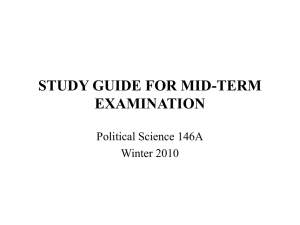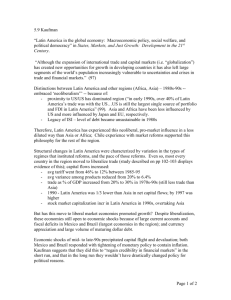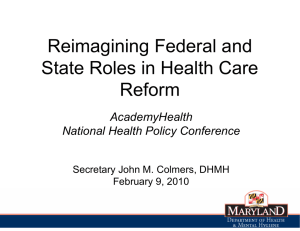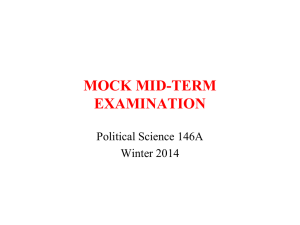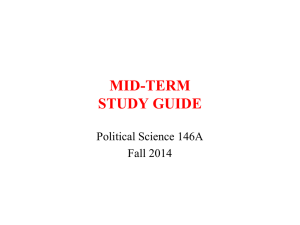Research Topic and Annotated Bibliography Instructions & Example By: Andy Hira
advertisement
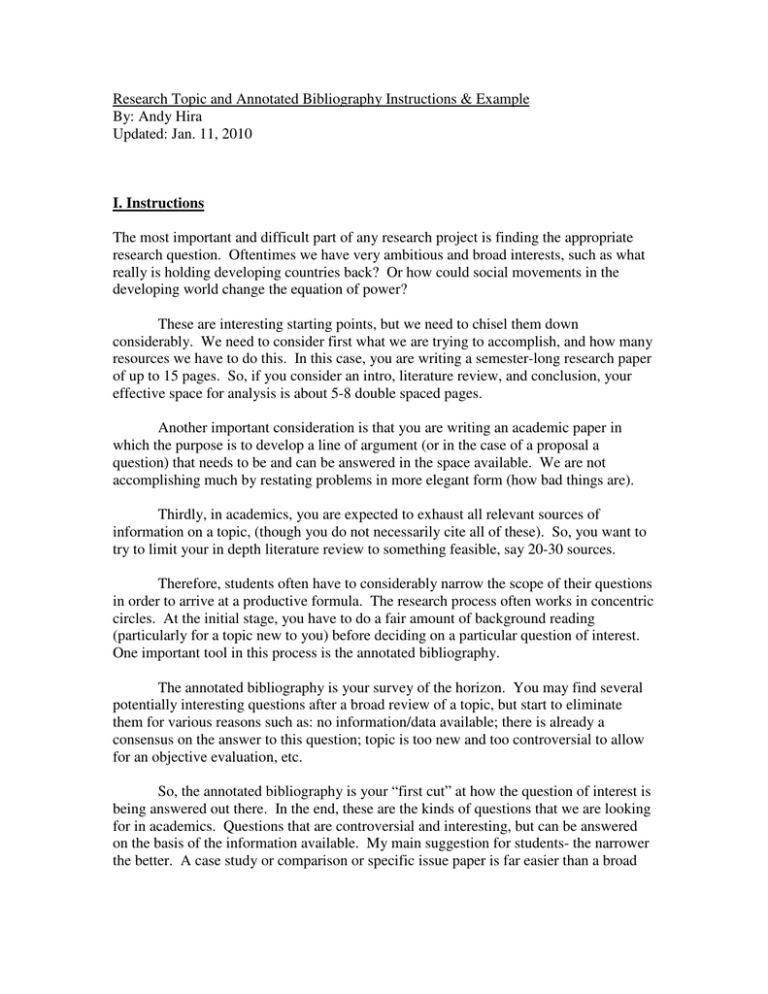
Research Topic and Annotated Bibliography Instructions & Example By: Andy Hira Updated: Jan. 11, 2010 I. Instructions The most important and difficult part of any research project is finding the appropriate research question. Oftentimes we have very ambitious and broad interests, such as what really is holding developing countries back? Or how could social movements in the developing world change the equation of power? These are interesting starting points, but we need to chisel them down considerably. We need to consider first what we are trying to accomplish, and how many resources we have to do this. In this case, you are writing a semester-long research paper of up to 15 pages. So, if you consider an intro, literature review, and conclusion, your effective space for analysis is about 5-8 double spaced pages. Another important consideration is that you are writing an academic paper in which the purpose is to develop a line of argument (or in the case of a proposal a question) that needs to be and can be answered in the space available. We are not accomplishing much by restating problems in more elegant form (how bad things are). Thirdly, in academics, you are expected to exhaust all relevant sources of information on a topic, (though you do not necessarily cite all of these). So, you want to try to limit your in depth literature review to something feasible, say 20-30 sources. Therefore, students often have to considerably narrow the scope of their questions in order to arrive at a productive formula. The research process often works in concentric circles. At the initial stage, you have to do a fair amount of background reading (particularly for a topic new to you) before deciding on a particular question of interest. One important tool in this process is the annotated bibliography. The annotated bibliography is your survey of the horizon. You may find several potentially interesting questions after a broad review of a topic, but start to eliminate them for various reasons such as: no information/data available; there is already a consensus on the answer to this question; topic is too new and too controversial to allow for an objective evaluation, etc. So, the annotated bibliography is your “first cut” at how the question of interest is being answered out there. In the end, these are the kinds of questions that we are looking for in academics. Questions that are controversial and interesting, but can be answered on the basis of the information available. My main suggestion for students- the narrower the better. A case study or comparison or specific issue paper is far easier than a broad large n or sweeping historical perspective. The latter open you up to too many gray areas that will mean your argument is weak and incomplete. In this class, we want to identify a question of policy interest. You might start your quest with the issue of whether utilities should be privatized, but find yourself drowning in the possible ways this is answered. And remember, different stakeholders and individuals will have different ideas about what is “best.” It is better to therefore to really focus on a narrower slice, such as Would privatization of BC Hydro lead to greater investment in electricity generation? And then find the criteria authors use to answer this question. Keep this in mind as you work steadily on your research. II. Examples Objective: The purpose of this study will be to understand the effects of neoliberal reforms upon developing countries’ financial systems. I will focus on the Latin American (LA) region, while drawing lessons from the general literature and lessons from other regions. This topic is extremely important, as the financial system plays a key role in a developing economy, creating connections among macroeconomic and microeconomic variables across the public and private sectors. Developing nations struggle on the macroeconomic level with high external debts, volatile exchange rates, high interest rates, and inflationary cycles. On the microeconomic level, weak banking systems, a lack of liquidity, weak fiscal policy, insecurity and lack of instruments in regard to borrowing and saving abound, creating additional serious obstacles to public sector entities needing to raise money to create new infrastructure and private sector companies seeking to capitalize and expand. Neoliberal reforms were supposed to solve these problems. Stable macroeconomic policy and expansion of exports would be used to pay back external debts, and to create confidence in the economy and its management institutions, thus braking capital flight. Independent central banks would offer realistic interest rates that broke inflationary borrow-and-spend cycles. Privatization and regulation of banking sectors would lead to competition offering better interest rates, increasing both savings and borrowing on better terms. Liberalization of trade and investment barriers would create lower prices for consumers as well as competition within the financial sector, creating a greater variety of more tailored financial instruments. Investment from abroad would re-capitalize sectors and employ more workers, creating export diversification and injecting new capital and technology transfer to developing countries. The patronage politics tied to fiscal deficits and state-owned enterprises would be broken as a newly competitive private sector, and tax reform and reduction of state subsidies, excess hiring and spending took place. Therefore, I propose to study 2 questions: 1) Did neoliberal reforms lead to improved financial management; 2) If so, what are the remaining challenges for financial reform; If not: a) was there an inherent flaw in the logic of neoliberal financial reform, and/or b) was there a failure in its implementation? Data Sources Financial Management- needs to be defined, but -Macroeconomic data are available through IMF, World Bank, and PennWorld Table indicators -finance ratings are available through interest rates of international bonds and ratings agencies -banking data are limited but there is some info available through BIS and InterAmerican Development Bank Conclusion: there are adequate data to examine this question The main problem may end up being that there are too many possible data points, suggesting that the scope may be too broad (q. can’t be definitively defined). Annotated Bibliography Neoliberal reforms: Mainstream Economist/+ view Bank, World. 2005. World Development Report 2005: A Better Investment Climate: Washington. discusses need for property rights and investment assurances as well as regulatory reforms (IMF), International Monetary Fund. 2006. Regional Economic Outlook. Washington: IMF. rosy outlook on LA financial markets Krueger, Anne O., ed. 2000. Economic policy reform: the second stage. Chicago: U of Chicago Press. comparable to WB in calling for a 2nd generation of reforms Singh, Anoop. 2006. Macroeconomic Volatility: The Policy Lessons from Latin America. In IMF Working Paper, edited by IMF. Washington: IMF. sees ties b/t exchange rate volatility and several other macroeconomic indicators, emphasizes diff b/t fixed and flexible exchange rates Ter-Minassian, Teresa and Gerd Schwartz. 1997. The Role of Fiscal Policy in Sustainable Stabilization: Evidence from Latin America. In Working Paper, edited by IMF. Washington. technical paper on fiscal policy reform, seems to be lacking political angle Mixed Results/Structuralist View Ffrench-Davis, Ricardo. 2005. Reforming Latin America's Economies: After Market Fundamentalism. NY: Palgrave MacMillan. sees neoliberal fin reforms as quite short-term in nature Mogullanksy, Graciela, Rogerio Studart, and Sebstián Vergara. 2004. Foreign Banks in Latin America: A Paradoxical Result. CEPAL Review 82 (Apr). raises some skepticism about benefits of privatization of banks Stallings, Barbara and Rogério Studart. 2003. Financial regulation and supervision in emerging markets: the experience of Latin America since the Tequila Crisis. In serie informes y estudios especiales. Santiago: CEPAL. discusses recent financial crises in LA Stallings, Barbara and Rogério Studart. 2006. Finance for Development: Latin America in Comparative Perspective. Washington: Brookings Institution, CEPAL. good overview of topic + discussion q.ing banking sector ownership Skeptical View Moran, Theodore H. 2002. Foreign Direct Investment and Development: The New Policy Agenda for Developing Countries and Economies in Transition. Washington: Institute for International Economics. mainstream eco institution, yet this author notes lack of knowledge about foreign investment fx leads to strong theoretical diffs Related Topics for possible follow up Mesa-Lago, Carmelo. 2005. Evaluation of a Quarter Century of Structural Pension Reforms in Latin America. In A Quarter Century of Pension Reform in Latin America: Lessons Learned and Next Steps, edited by C. A. Crabbe. Washington: Inter-American Development Bank. seems to be the foremost expert on this topic, has written many books and articles on it Other Notes: sources focus mainly on economic variables- and scope seems too broad -still looking for political sources of financial weakness- could be a good angle/focal point for the paper

